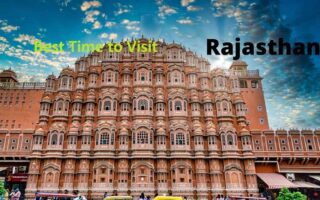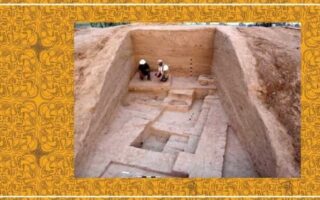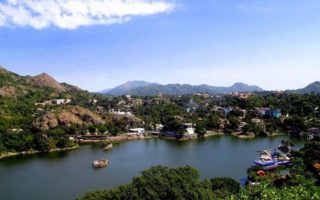Rajasthan monuments are one of the major attractions of the Rajasthan. Your trip to any popular Rajasthan monuments would be a lot exciting and amazing trip. Rajasthan monuments comprises of dargahs, temples beautiful mansions and observatories. Architecture of Rajasthan and monuments are the visual treat for your eyes but it makes difference from Rajput to Mughal to European. You will observe that every place of Rajasthan has historical monuments touch which gives beauty to state. Each monument has different and interesting History and also the architectural tradition which you can find only in monuments.
The monuments of Rajasthan have survived a long time and offers a glance of diverse culture and traditions of India. In tourism sector of Rajasthan, monument plays very beneficial role. Through Hub of monuments, Rajasthan shows the romantic mood of kings. After so many years, calamities and many other problems still even today the construction of monuments are spreading their charm in around the world. Rajasthan has a great history of 5000 years and the monuments are somewhere footprints of the royal past of the Rajasthan. You will get to see several historical monuments which are unable you get introduce with old worldly Rajasthani charm. The style of architecture is different in each Rajasthani monuments. Like in some monuments you will observe the Rajput style and in some other monuments you will get the feel of mixture of Hindu and Mughal style architecture.
The pink city Of Rajasthan is a perfect tourist attractive spot which contain Hawa Mahal and Jantar Mantar; these couple of structures comes in the City Palace complex premises, these monuments are known as heart of Jaipur. When you will move forward, you will get to see the magnificent city Jaisalmer; this city is a real showcase of Havelis. Every of these extraordinary cities include of 3 or more storey in courtyard’s surrounding area. The major attraction of Jodhpur is Mehrangarh but still the Umaid Bhawan has that much glam that it captures every tourist’s notification. Other monuments are like a Lake Palace of Udaipur, it is a huge summer season palace of Royal family and there is also Palace of Padmini, the royal Mewar queen, it is established in the Chittorgarh.
City Palace Udaipur
- Location: Udaipur
- Architectural view: Hanging gardens, miniature paintings, arches, sheesh mahal, museum
- Established by: Maharana Udai Singh
- Other attractions: Shores of Lake Pichola
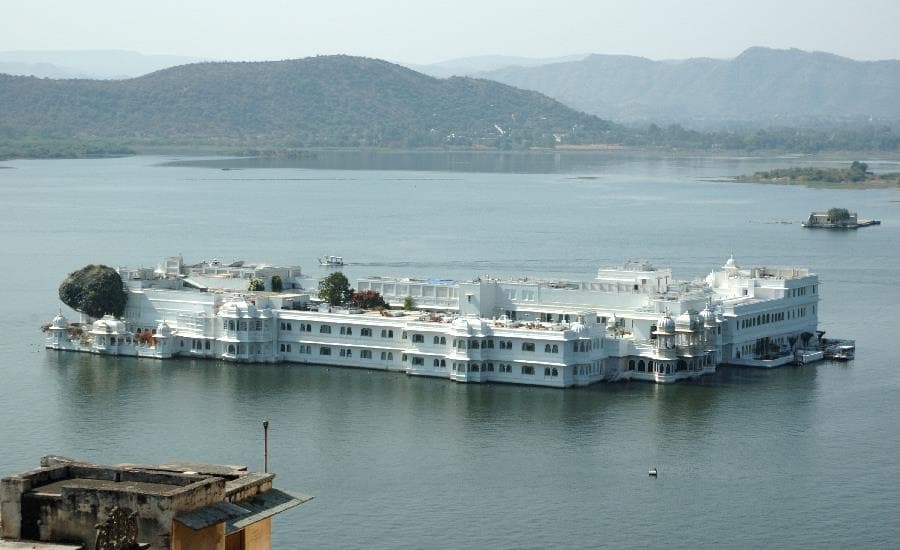
City palace was established by the Maharana Udai Mirza Singh, it was built in the 1559, Sisodia Rajput clan, after when he carried head from the Chittor. This is situated over the bank of eastern side of Pichola Lake and there are many palaces under construction in its compound the previous kingdom Mewar, Udaipur was a historical capital during the Agency of Rajputana & its final capital in the Rajputana agency. The palace of Udaipur was constructed in the style flamboyant and in its style it is considered the largest in Rajasthan.
The palace is an amazing mixture of the Mughal and Rajasthani architectural pattern and because it is constructed over the top hill that offers a panoramic look of city. Its surrounding includes many historic monuments like the Jag temple on other island, the Lake Palace in Lake Pichola, the Jagdish temple near to the fortress, the Neemach Mata temple and the cloudburst Palace on the high part of hillock close by. The consequent promotion has been concluded in the appellation of Udaipur as ‘Venice of the East’. Udaipur was on the peak city position out of the world cities and also rewarded.
- Also Read: Popular Temples of Udaipur
Hawa Mahal
- Location: Jaipur
- Architectural view: Multi layered Red and Pink Sandstone building
- Established by: Maharaja Sawai Pratap Singh
- Other attractions: Hawa Mahal Museum
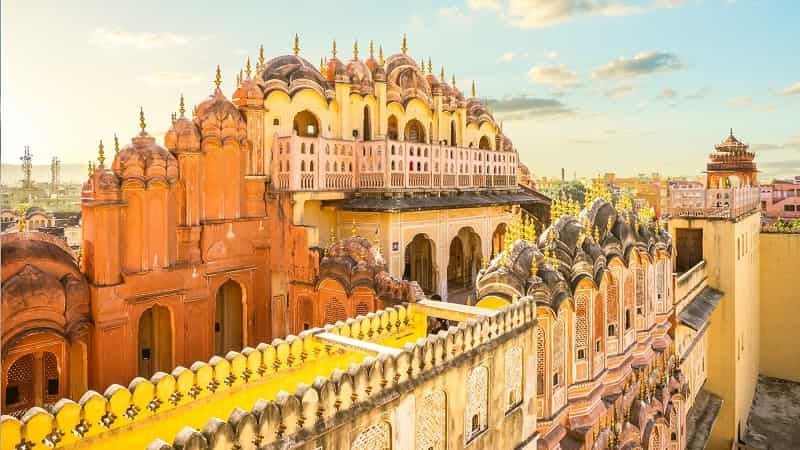
Hawa Mahal is signature structure of Jaipur. Hawa Mahal palace was constructed by Maharaja Sawai Pratap Singh in 1799 and Lal Chand Usta designed this monument in the style of Krishna crown (Hindu God). The palace’s exclusive 5 storey exterior is similar to of the beehive as per its nine hundred fifty three tiny windows, which called Jharokhas; these Jharokhas are designed with beautiful lattice work. The real motto behind this lattice work was to provide facility to royal ladies so that they can observe the daily life of the street behind in person seen, because they have to follow the traditional rule of ‘purdah’. The whole palace is built of pink & red sandstone, because of which its being the centre of attraction in the Jaipur’s business centres. It has created parts of the City Palace and also extended till the Zenana area (women’s chamber or room) if you will see this palace while the morning your eyes will defiantly blink, by looking at the golden palace, because of the sunrise, the palace glows tremendously.
Maharaja Sawai Jai Singh was the real planner and builder of the Jaipur city. He was also the emperor of the Kachwaha clan of the Rajasthan. Hawa Mahal was built by the Sawai Pratap Singh in 1799; he was the grandson of the Maharaja Sawai Jai Singh and Maharaja Sawai Madho Singh I’s son. His great worship or devotion towards Lord Krishna encouraged him to construct it as a commitment, in the type of a Mukut of headgear, beautifying the Lord. There are no exact because of the ancient record, but it was related to the royal family women, at that time they were under very harsh observation of ‘purdah’ in which they were not allowed to see by males. They had given chance to eyewitness proceedings within the center of market to see the rich processions an festival occasions by sitting backside the carved screens of stone. Hawa Mahal just did not have that style construction but there were comforts for royal women and behind the strict carved screened walls there was exclusivity, freedom to do anything but unwatch by outsider tourists.
Lake Palace
- Location: Udaipur
- Interesting view: Lake Pichola
- Belongings: Summer Residence of The Royal Family
- Other attractions: it is now converted to a heritage hotel
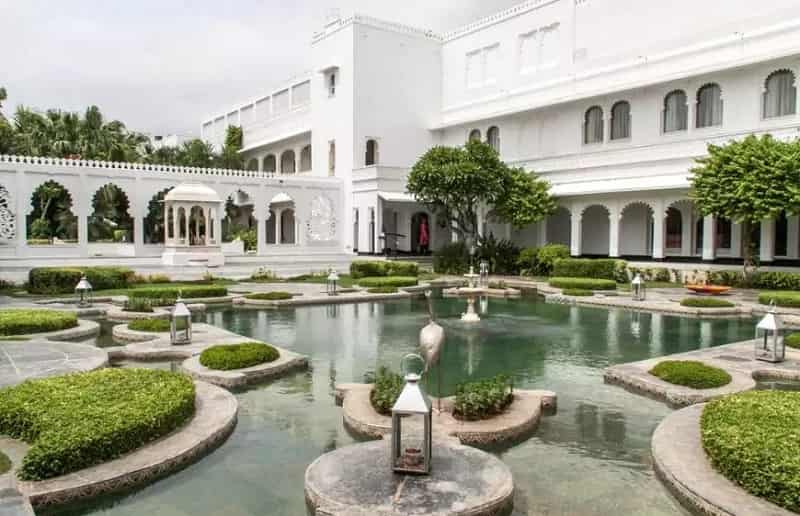
Lake Palace was built below the Maharana Jagat Singh II’s guidance of Udaipur state Rajasthan in 1743. He built this palace as a rich summer palace, in the beginning it was called as Jan Niwas or Jag Niwas later than its establisher. From 1628 to 1654, the Maharana emperor of city Jaipur was very sociable with the emperor of Mughal Shah Jahan and started encouraging his craft artisans to duplicate few of the beautiful aspects of his default structure at Agra. Lake Palace was built as east facing, allowing its culture group to worship the god Sun at the dawn crack. The succeeding emperors were using this cool heaven as their resort of summer, keeping their royal durbars in the palace’s courtyards aligned with pillared terraces, Gardens, columns and fountains. You will be surprised by seeing the palace’s upper side room, this is a just right circle and it is around twenty feet in distance.
The flooring is decorated with white & black marbles, the ramparts are made beautiful by using the ornaments with decorated & niches with different colored stones as same as Agra’s Taj. In is built in Hindu pattern and the dome is extraordinarily delightful in form. They have used 12 enormous marble’s slabs to built the room, Shah Jahan’s throne was made until the one block of winding & there have also built little mosque which is devoted to Baba Kapuria. The other interesting objects are a Mohammedan Saint, over the island. During the popular Indian Sepoy Mutiny, during the year of 1857 many families European fled. It was offered those by Maharana Swaroop Singh. The Rana demolished the entire town’s boats, to protect his guests; because of this the rebels couldn’t arrive to island. In the later half of the 19th century weather & time taken their fee on the extra water at Udaipur palaces. One French writer has described that Jag Niwas as gradually moldering in the lake’s humid emanations.
Umaid Bhawan Palace Jodhpur
- Location: Jodhpur
- Established in: 20th century
- Other attractions: Converted into luxurious palace and museum

Umaid Bhawan palace is most of the world’s biggest exclusive houses. It is located in city of Jodhpur, Rajasthan. Some portion of the fortress is operating by the Taj Hotels. After the Maharaja Umaid Singh; it got the name. Umaid Singh was grandfather of current owners of this palace. 347 rooms this memorial has and offers as the prime house of the previous Jodhpur noble family. During the construction, because of its location, the Umaid Bhawan Palace was known as Chittar Palace. To start the construction Palace, ground was busted on November 18, 1829 by King Umaid Singh and in 1943 the manufacture work was finished. It was built in the southeastern area of the Jodhpur, over the Chittar hill. For the construction more than five hundred males were employed for 15 years. The construction was different than the usual, to bind the stones together, they didn’t use cement or mortar, all the pieces of the stone were carved and they joined it jointly by the carving system, inter looking negative & positive pieces. At that time to transfer these large & weighty blocks of rock, they used specially constructed train line. As every monument or building has one or more unique things like that this palace also has that this palace is made in such a method, that the palace always maintains their temperature approximately at 23 degree Celsius.
Ground of this palace covers 26 acres, out of this much, he built area covers three point five acres and the rest of the 25 acres are dedicated to the lawns. The palace was deliberate by famous architect Edwardian Henry Vaughan Lanchester and Budhmal Rai Indian architect. Umaid Bhawan fortress is a combination of western & eastern influences of architectural. The building’s premium middle dome, a majestic one hundred five foot towering cupola is inspired by he Renaissance, the towers are real inspirational design from the tradition Rajput. The total cost of the project was ninety four lakh fifty one thousand five hundred sixty five rupees to the Maharaja. The major resident of this plan was Hiranand U. Bhatia. Maples of London designed interiors for this palace. The vessel transferring them in the 1942 was sunk through the Germans. Result was Maharaja offered the facility of a Stefan Norblin interior designer. Palace has been decorated by the lavish gift of furniture ad elegant artwork which follows the Deco Art style, by the foreign murals Stefan Norblin polish artist complemented.
Deeg Palace
- Location: 34 km from Bharatpur
- Established in: 1722
- Established by: Badan Singh
- Other attractions: palaces, gardens and fountains and old fortress

This place is located 34km from Bharatpur. It is an historical village of Deeg. You will find the mention of this town into Skanda Purana as ‘Dirghapura’ or ‘Dirgha’. Deeg place is known because of it’s popular palaces, fountains and gardens. The old popular fort of Deeg were contributed significantly in the creation of principality of Jat. It is now in ridiculous condition. In the forlorn fort, its frightening cannons now recline. The newly carved state, Deeg was 1st capital of that; at that time Badan Singh had announced ruler of its in 1722AD. The royal palace was constructed by Badan Singh, in the garden’s southern side; which is now known as the old palace or Purana Mahal. Deeg was a prior and beneficial location because the closeness to Agra & Mathura was helpless to frequent attacks through invaders. The prince Surajmal, in 1730AD was informed to have erected the huge fortress with very tall walls, a bottomless moat, bastions and high ramparts around 20 feet wide, on the town’s southern portion. After some time Surajmal shifted his Bharatpur capital, but his liking towards Deeg had not decreased. He made adorable Bhawans in the surrounding of garden complex, with the scenery of mountains in the front and huge water bodies within the back.
The whole complex of gardens & palace is a fabulous example of engineering. You won’t get the opportunity to see this kind of elegant design and excellence of workmanship in this palace, any where else within India. The palace is from quadrangle, garden is in the centre, a rest space of one thousand forty five hundred by one thousand seven hundred, covered by the fountains & flower beds. On the east and west side there are masonry tanks, and also there is another garden which is on another side of the tank of western, ahead the buildings, developing the courtyard. The structure which is on the north side is called the Nand Bhavan. To the west side building called as Gopal Bhavan and this is largest in whole palaces. On the Gopal Bhawan’s either side there are 2 minor buildings, which called as the Bhadon & Sawan Bhawans. These two small buildings and Gopal Bhawan control a sight of the gardens and western tank ahead it. These 3 palaces and single storey on the front side have in accumulation 2 more floors on the bank. The unique thing is one of the storey of these places is wholly or partially submerged with water all through the year.
Jaipur City Palace
- Location: Jaipur
- Architectural view: Blend of Rajasthani and Mughal Architecture
- Established by: Jai Singh
- Other attractions: Palace Museum, Rajasthan, Chandra Mahal, Govind Dev Temple
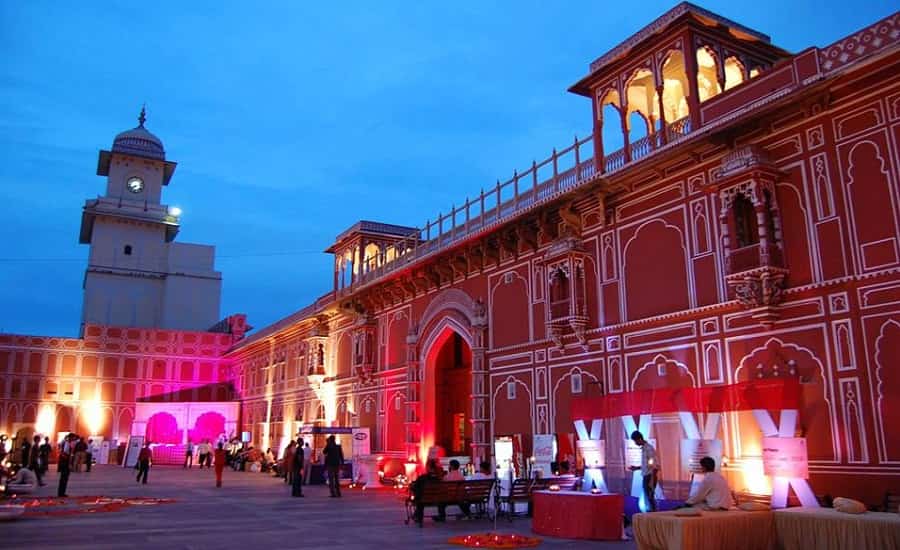
City palace is a fine mixture of Mughal art and traditional architecture & Rajasthani. The complex of city palace includes various palatial structures. The City Palace is located in Old Jaipur city’s heart; this city palace covers a huge area which is distributed into a courtyards series, buildings and gardens. The construction of palace completed in different periods, the outside wall of the palace was built by the Jai Singh and after sometime the other additions were done, some where in the beginning of the this century. In some part of the palace; the former Maharaja is still living. The city palace has covered over the one seventh are of the city of walled. It includes the Temple of Govind Dev, Chandra Mahal and the Museum of city palace.
At 1st you will see in the palace is Mubarak Mahal; it was built by the Maharaja Madho Singh. This mahal has marble gate which is delightfully carved, it has a heady doors of brass on the both sides gate. Out of this gate, you will get to see the Diwan-E-Khas or the Private Audience Hall also a gallery of marble. Across a coated square lies the Hall of Public Audience or ‘Diwan-E-Am with its complex manuscripts and decorations in and Sanskrit & Persian. In the newer Mubarak Mahal, there is clock tower. To the West North sides of the Mahal, is the beautiful and stately seven storeyed Chandra Mahal, it was a house of old ruler. The 7 story Chandra Mahal is a center of attraction and gives graceful scenery of the Jaipur city & gardens. The palace includes an armory, a fabulous museum and numbers fine halls. The structures are very well managed in deluxe order and there is also Maharaja Sawai Man Singh II’s museum, there is album of art, old weapons, carpets and enamelware. In the paintings you will get to see the miniatures of Rajasthani, Persian schools and Mughal. The armory was date back in the fifteenth century and several dangerous and complicated weapons, for which the warriors Rajputs were popular for. One section of the museum consist costumes & dresses of the earlier Maharanis and Maharajas of the Jaipur city. Each storey of palace has different story and it is a monument of precipitous luxury & beauty. Floral beauty, ceilings, paintings, mirror walls are the major factor which has been used to decorate the palace in traditional style. The uppermost floor called as the Mukut Mahal.
In the middle of the Chandra Mahal and the Badal Mahal, the temple of Govind Devji established. In the middles of the paved path which is situated between the Chandra Mahal, a beautiful system has been placed of the mountain. This huge palace has huge and comprehensive gardens. After coming out of the palace you will see the silver vessel, the earlier Maharaja were usually carry drinking water to England; because of some Hindu rituals King could not have the water of English. Visiting this palace would be an amazing experience for you.
- Must Read: Most Famous Museums of Rajasthan
Manak Chowk
- Location: Rajasthan, Jaisalmer
- Architectural view: Carved Havelis
- Progressed in: 18th and 19thcentury.
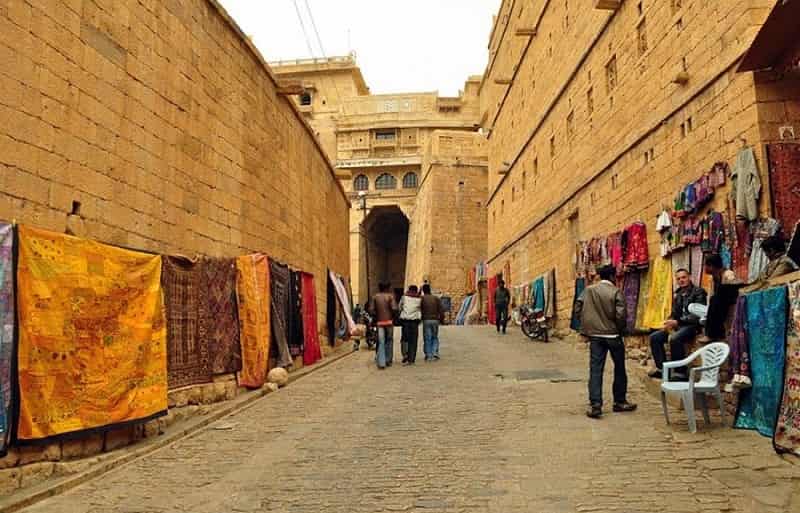
Manak Chowk is the place which comes outside the fort, the main market place. It is the chief market place outside the Jaisalmer fort and it is a major centre of local activity. The major carved havelis you will found at a short distance from the Manak Chowk. Each haveli is makes difference form each other. The Havelis are mostly built during the 18th and 19th century period. The monuments which are in the havelis of Jaisalmer are very much developed. In the Manak Chowk, there is famous Sadar Mandi and a trade of beehive. There are many nations, which are visited this chowk for trade such as Iraq, Arabia, Persia and Egypt. Manak Chowk is a very much popular market in Jaisalmer, it is a near by to the Jaisalmer fort. You can see the loveliest haveli called Patwon-ki-Haveli; its frontage is decorated by the beautiful latticed. You can see the three century’s old Salim Singh ki Haveli which is still surviving. The roof of the haveli is very nicely carved brackets, shaped of peacocks. Nathmalji – ki – Haveli is a royal mansion which was built by the two architect brothers, each of them were concentrating on the different sides. You will get to see several attractive places in Manak Chowk, here people do roaming for various purposes such as to visit lovely haveli and shopping.
Among the attractions of Jaisalmer Manak Chowk is a major one. It is very well connected through means of transportation which helps you travel easily. To travel in Jaisalmer you can use local buses, taxi, jeep, and car. Among this hired taxi or jeep would be suitable for you. Manak Chowk is a very interesting and fulfilled by various flavors, which you should taste.
- Must Read: Best Things To Do in Jaisalmer
Vijay Stambh
- Location: Chittorgarh
- Architectural view: Nine storeys, 37mts
- Established by: Maharana Kumbha
- Other attractions: 1440AD
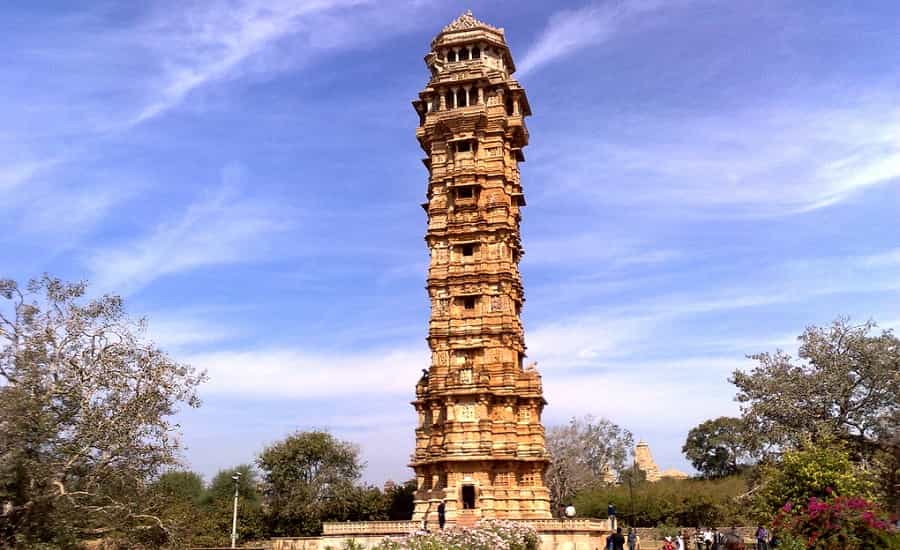
India is filled with many tourist attractions, among that Vijay Stambh of Chittorgarh is one with great significance. Vijay Stambh was constructed by Rana Kumbha in the year of 1440AD as a memory of his victory on Mahmud Khilji of Malwa. This structure is a best example of marvelous architecture. It is nine stories tower, its architecture and design is perfect proof of the dexterity of the Chittorgarh’s artisans. Its terrace has one fifty seven circular and narrow steps. Vijay Stambh’s terrace gives a dynamic view of the elegant town of Chittorgarh. 10 years was taken by the employs to complete the construction of this tower. To add more beauty, Vijay Stambh is decorated by using the sculptures of Hindu God and memorable scenes of great epic Mahabharata and Ramayana. Some part of this tower is built in red sand and some part in white marble and advance by several pictures of Hindu deities and goddess. This Stambh look like it has completed 10 years.
The interior of this tower especially staircase gets alternately winds by surrounding galleries and central chamber. The whole stambh is covered by beautiful ornaments and graceful images of seasons, god and goddesses, weapons and musical instruments etc. the unique thing about this tower is, there are carved pictures of tower’s architect Jaita, his 3 Childs Puja, Napa and Poma on the fifth floor of the tower. Visiting the Vijay Stambh is very huge and artistic experience.
Havelis
- Location: Jaisalmer
- Established by: Jaisalmer’s wealthy Merchants
- Major attractions: Salim Singh Ki Haveli, Patwon ki Haveli
The huge and beautiful mansions built by the Jaisalmer’s wealthy merchants are known as ‘havelis’ and many of the sand stone buildings are still in the beautiful and well-maintained condition. Among the Jaisalmer havelis, the Patwon ki Haveli is the most beautiful and detailed haveli. This haveli stands in the narrow lane and one of its apartments is colored with nice murals- but at present this haveli is closed up and not open for anyone. The haveli which is still lived in is Salim Singh ki Haveli; it was built around three hundred years ago. When the Jaisalmer was the capital of a princely state, that time the Salim Singh was the prime minister. The havelis has a delightfully arched roof with nicely carved brackets in the form of peacock. The haveli is just the below the hill and there is saying that once had two storey in an attempt to build it as towering as the palace of Maharaja. The Maharaja of the Haveli had turned the storey down. In the late 19th century the Nathmal ki Haveli was a minister’s house. The wings of the haveli left and right were very nicely carved by brothers and the carving is very similar but not identical. The yellow elephant made of sandstone are places at the front door alone, it is a work art.
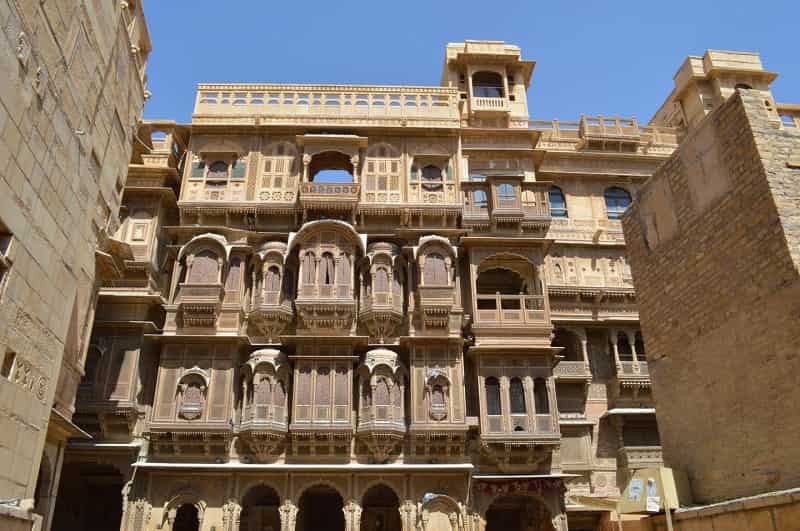
Patwon Ji Ki Haveli
It is one of the prime haveli in Jaisalmer and placed on a lane of narrow width. It is 5 floors tall and is finely carved. The haveli is partitioned into 6 complexes, 2 parts of the haveli are owned through families, they manage the craft-shops, two by archaeological survey of India, 2 separate houses. There are footprints of pictures on few of the inside walls also you can see few works of mirror.
Nathmal ki Haveli
This haveli appear to Nathmal, after some time it was gifted to the Rawal from prime minister. It was built by two brothers in 1885. Nathmal ki haveli has two identical looking portions, which are originally two different parts but united by a common façade. This haveli is a best example of jeweler art which belongs to stone carving. The Muslim artisans did a great work in this haveli and they left the fabulous legacy of craftsmanship excellent in detail and flawless in conceptions.
Salem Singh ki Haveli
It is an Arabian night’s structure, which is like a wild flower, at top of the haveli, there is blossoms. Salem Singh ki haveli has survived from over three hundred years and a part of it is still occupied. When the Jaisalmer was the capital of the princely state; he was a prime minister. His haveli was decorated by a beautiful roof arched with fine brackets which are carved in the type of peacocks. Salim Singh’s mansion is just under the hill and there is saying that once it had two additional wooden storeys in an endeavor to make it high.
Jantar Mantar
- Location: Jaipur
- Architectural view: Astronomical Observatory
- Established by: Sawai Jai Singh II
- Established In: 1716 AD
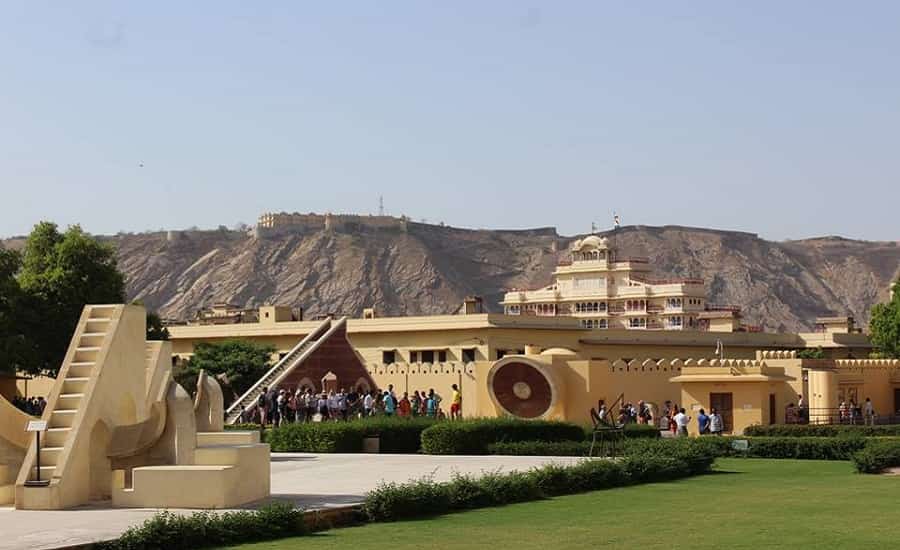
Jantar Mantar is as unique attractive monument as its name. It is a very important structure. It was constructed by Sawai Jai Singh II; he was a princely state’s ruler Amber and a same period Mughal Aurangzeb emperor. There are various constructions in the Jantar Mantar monument, which are actually instruments which were used to maintain the celestial bodies’ track. Jantar Mantar is a timekeeper and also it gives much information about the success of technology which they achieve under the Rajput kings and reviling the secrets which contains the astronomy. Sawai Jai Sigh II has built five observatories, Jantar Mantar is one of them which he built in Delhi and the rest four are situated at Jaipur, Ujjain, Mathura and Varanasi. All this structures are built during the period of 1724 – 1730, the period which is called as the Indian history’s Dark Age. Because in that period last Mughal Aurangzeb emperor died and also the empire of Mughal demolish rapidly.
While chaos time, Muhammad Shah got the power of Mughal Empire. Many enemies of his are in the surrounding area, that’s why he demanded collaboration with the rulers of Hindu. At that time the notable emperor was Sawai Jai Singh II came into focus from the day of Aurangzeb. In 1699, Emperor Jai Singh got the power of Amber, he was in whisper eleven, and he was but very cleaver and smart than his age. Emperor Aurangzeb was very much affected with the Jai Singh II the young emperor. Aurangzeb gave the title of Sawai to Jai Singh II. The meaning of Sawai is power of one and more people’s in one man. Again and again Jai Singh II was proving himself worthy Mughal’s. The dependable friend Muhammad Shah was selected over the Jai Singh for the position governor of the Agra and after some time Malwa.
The sciences and arts, chiefly astronomy, Jai Singh II was very much passionate. One day he saw that the Muslim & Hindu astrologers were doing argument on the planetary position in the Muhammad Shah court. It was very much important to find the accurate positions to do the auspicious hour to emperor and set the expedition. That time Jai Singh suggested the suitable astrological tables and offered which will acceptable from side of Mughal emperor. Result of this moment, there are many symbols inside the Jantar Mantar which display the interest of Jai Singh in astrology like sun, planets, moon all this you can see in the Jantar Mantar. It was Jai Singh’s thought that to make an awakening of the practical astrology between masses of Indian and to encourage to do astrology.
Some Jantar Mantar’s ideals are not fulfilled because at that time, the country was in turmoil that’s why they were not able to give full attention to this monument. In the starting of this monument he was trying to use material of brass but then he gave upwards, because of many congenital flaws. Their instruments were small and the axes were also useful, because of this the center always got displaced. After all this problems he decided to adopt the style of the Arab astronomer his name was Prince Ulugh Beg, he was maker of the popular 15th century tower at Samarkand. The important instruments which are at Samarkand are suited to the Jai Singh’s structure tastes and more correct because of its sheer size. To the King of Lisbon emperor, mission was sent, in 1730. On the return mission, it brought back an abstract and there was not single person rather than the astronomer court, name Xavier de Silva. Footprint of all this things you can observe inside the Jantar Mantar. The whole history of Jantar Mantar has displayed in the monument.
Palace of Padmini
- Location: Chittorgarh
- Established for: Rani Padmini
- Established In: 13th century
- Other attractions: it was built inside 7th Mauryan fort

Several forts and palaces of Rajasthan are the picturesque of the great history of beautiful place of Rajasthan. A huge number of tourists come to this place to have a look of this historical monuments. In Rajasthan, Chittorgarh is one of the most historical important palaces. There are several palaces and forts here. These are somewhere deeply relate with history of Rajasthan. The palace is built besides the pool of lotus, which has changed the history of Chittor. The reflection of Queen Padmini was seen by the Ala-ud-din. He mesmerized by the dangerous battle which he saw among the Queen Padmini and the last of Maharaja Ratan Singh. It was legendary history of Mewar state and Chittor. The palace is very graceful and delightful. If you want to gain the full knowledge about the palace then the best place would be the capital of Mewar which was ruled by Rajputs. Mewar is situated in the South of Chittorgarh.
The palace was committed to Queen Padmini and is a nice place to visit. There is one fact about the Chittor that it is a place of warriors. Rani Padmini is a popular personality of Rajasthan. She was a wife of Raja Ratan Singh who was ruler while the 1300 century of Chittor. To dominate her Allaudin Khilji invaded Chittor. So to avoid disrespect of herself, she did jump into the pyre. This situation describes the spirit and power of Rajputs. This monument is a symbol of sacrifices which Queen Padmini did. Palace of Padmini also has History of attack did by the Mughals.
The attraction of this palace is it’s feminine structure. There are some architectural features which are watchable and noticeable. Besides the palace, there is pool. You will also get to see at palace’s centre, the pavilion. The architecture of this palace has a nice touch of Rajasthani architecture. People who come to the Chittor, they can stay in the heritage properties, palaces and havelis which are now converted in the hotels. So there is not such problem about stay. Tourists are free to visit this place at any time.
These monuments showcase the architectural prowess, history, and culture of Rajasthan, making it a prime destination for travelers interested in exploring India’s past and heritage.
